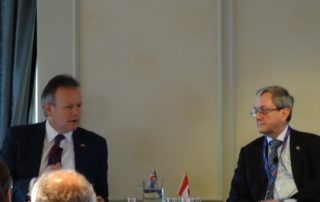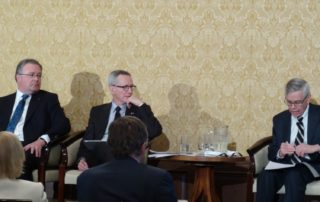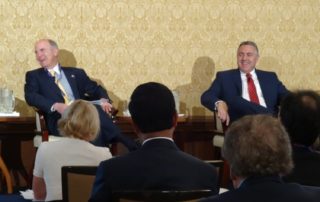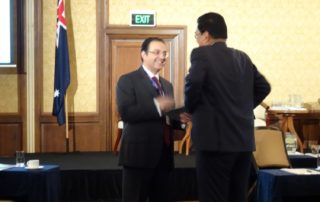2014 Forum – Melbourne, Victoria, Australia
2014 Australia-Canada Economic Leadership Forum Organising Committee
Co-Chairs:
Thomas d’Aquino
Chairman, Thomas d’Aquino Capital; Chief Executive, Intercounsel Ltd.;
and former Chief Executive Canadian Council of Chief Executives
Heather Ridout
Chair, AustralianSuper; Board Member, Reserve Bank of Australia; Company Director; and former Chief Executive, Australia Industry Group
Members:
Dennis Cliche
Managing Director, ConnectEast Group and Honorary Consul for Canada in Victoria (Australia)
Paul Donnelly
Executive Director, Global Head of Equity Capital Markets and Global Head of Debt Capital Markets Macquarie Capital (Australia) Limited
Louise Hand
Australian High Commissioner to Canada
Stanley Hartt
Counsel, Norton Rose Fulbright Canada LLP and 2010 Co-Chair, Australia-Canada Economic Leadership Forum
Portia Maier
Consul-General & Senior Trade and Investment Commissioner, Australian Trade Commission (Austrade)
Greg McNab
Partner, Baker & McKenzie LLP and Canadian Chair, Canadian Australian Chamber of Commerce
Bob Onyschuk
Chief Executive, Onyschuk Strategic Advisors;
President, Australia-Canada Economic Leadership Forum; and former Chair, Canadian Urban Institute
Michael Small
Canadian High Commissioner to Australia
Mario Ste-Marie
Canadian Consul General in Australia
Jeffrey Steiner
Chief Executive, New Franchise Media Inc. and Board Member, Export Development Canada (EDC)
Executive Director:
Ann Curran
2014 Australia-Canada Economic Leadership Forum
BUILDING ON STRENGTH AND SEIZING OPPORTUNITY
February 24-26, 2014 in Melbourne, Australia
RAPPORTEUR’S REPORT
The third Australia-Canada Leadership Forum, a conference of about 140 senior private and public sector leaders from both countries, spent two days analyzing a wide range of issues – from fiscal and monetary policies, to trade and economic prospects, to cultural and educational approaches, to foreign policy and security issues in the Asia Pacific. The conference reinforced the friendship and similarities between the two countries, and the lessons that can be learned one from the other. It also underlined how, as federal countries with shared values, parliamentary systems and historical experiences, Australia and Canada remain constructive bilateral partners and forces for peace, stability and open markets in the international system.
The 2014 Forum, co-chaired by business leaders Heather Ridout of Australia and Thomas d’Aquino of Canada, was particularly well-timed. It took place following the G-20 meeting of finance ministers and central bank governors in Sydney, with the result that the ministers of finance and governors of the central banks of Australia and Canada were able to attend the Melbourne meeting. So did the foreign ministers of Australia and Canada.
Of special importance was a presentation made by The Honourable Tony Abbott, Prime Minister of Australia since September 2013. The presence of the Australian Prime Minister and other senior political leaders underscored the general importance of the Australia-Canada relationship, and the particular importance the current governments attach to the relationship. In all the presentations made by the political leaders, the shared values of Australia and Canada were emphasized, as were the similar political perspectives on domestic and foreign policies by the governments of Prime Ministers Tony Abbott and Stephen Harper of Canada.
Mr. Abbott, in his address to the conference, said that although the relationship “doesn’t figure in each other’s headlines,” he nonetheless wanted to “broaden and deepen the relationship.” He described the overall Australia-Canada relationship as “strong but underdeveloped.” Indeed, he hoped to visit Canada in 2014 in keeping with the objective of further strengthening relations.
Mr. Abbott praised the Harper government for having cut taxes, campaigned against a carbon tax, (all but) eliminated the federal fiscal deficit, and brought a “robust common sense to world affairs.” Inspired by this Canadian approach, Mr. Abbott explained that his government also intended to lower taxes, trim the size of the civil service, reduce regulations and balance the budget, all of which he believed would lead to “more revenue and more jobs.” He offered particular praise to the Conservative Party of Canada, with which his Liberal Party has developed strong links, saying “we recognize how much we have learned from you.”
A recurring theme at the conference, coming as it did after the G-20 meeting, was the challenge of stimulating more economic growth in the two countries and in the world economy. A particular challenge for Australia and Canada in this context is that governments are either running deficits or have barely balanced the budget whereas the private sectors have a great deal of money that is not yet being invested. The fiscal challenge facing both countries occurs as populations are aging, with implications for higher health-care costs and fewer people in the workforce. Therefore, speakers emphasized that governments needed to keep taxes low, and preferably to lower them, and to find other ways of stimulating private sector investment. These include securing bilateral trade agreements, such as Australia has recently accomplished with Korea and Canada with the European Union. Additionally, economic growth would be helped by pushing multilateral trade agreements to successful conclusions, such as the Trans-Pacific Partnership in which Australia and Canada are both participants. No participants seemed optimistic about early progress in the Doha Round of multilateral trade negotiations.
Another way of stimulating private-sector activity is private investment in public assets, be it through private-public partnerships or private purchase followed by regulated management of public assets. A great deal of discussion occurred at the conference about the methods of financing and regulating such private partnerships, since Canadian private capital has been invested in infrastructure projects in Australia, and vice versa. Indeed, it was estimated that investments by the two private sectors in each other’s country now exceed $40-billion, with opportunities for additional investments appearing to be quite considerable as governments wrestle with balancing their fiscal challenges and the need for infrastructure spending on roads, public transit, water systems, ports, rail, pipelines, hospitals and the like.
Experience in both countries suggests that a challenge is always present in finding the right balance between appropriate regulation and substantial private capital investment. Among the requirements for successful private-public partnerships are a) demonstrable demand for infrastructure, b) availability of private capital, c) political support for using private capital for public projects, d) social acceptance, and e) appropriate financing and regulatory models. Many, if not all, of these requirements are present in both countries, which explain the proliferation in recent years of private-public projects, and the likelihood of many more coming on stream in the years ahead. Since both Australia and Canada, despite their enormous geographies, are countries with the vast majority of their populations in cities, urban infrastructure projects are particularly urgent, since vibrant cities are engines of economic growth that attract human capital. Happily, on the conference’s eve, Melbourne ranked first for “liveability” among world cities in an international survey. Other cities in the top ten included Vancouver, Toronto, Sydney and Montreal. In order, however, for leading Australian and Canadian cities to remain attractive, vibrant and “liveable,” large infrastructure investments will be needed.
A lively session about the role of cultural institutions underscored the importance of making cities attractive places to live. Participants heard that as public funding for arts institutions is coming under increasing pressure, these institutions are seeking new ways of engaging private philanthropy. Cities, as incubators of the “knowledge economy”, need to continue to attract people with considerable skills, and they compete among themselves to some extent in this way. A vibrant cultural life is what these kind of “knowledge” workers look for when deciding where to live. Companies, too, need to attract the best human capital they can, so a vibrant cultural life in a city assists companies in their search.
Attracting human capital was frequently raised by business leaders as a key to their companies’ success. Change is occurring so swiftly, and competitive pressures are so great, that companies will flourish only if they handle change successfully. This means attracting and keeping adaptable, creative people, especially in the digital age where constant disruption is the wave of the future. As open economies, with large private sectors, Australia and Canada cannot shield themselves from these changes, but because their economies are indeed open and flexible, and their workforces reasonably well-trained, they might both benefit from the onrush of change.
World markets
As trading nations, Australia and Canada cannot remain immune from economic trends around the world, especially in G-20 countries and emerging markets. Companies’ prospects are also influenced by the relative values of the local currencies. In that connection, many Australian participants suggested that their country’s dollar had been over-valued, lifted to approximate par with the United States dollar by strong commodity prices. This high dollar had hurt manufacturing, an observation that resonated with some Canadian participants. The Australian and Canadian dollars had fallen to about 90-cents (U.S.) by the time of the conference. Some Australian participants suggested their dollar remained over-valued. (The Canadian dollar was at approximate par with the Australian dollar.)
Many participants predicted a continued growth rate for China of about 7-8 per cent but continuing uncertainty about other emerging economies such as India, Brazil and Indonesia. The United States, many participants believed, appeared on track for perhaps 2.5 per cent growth but Europe would remain plagued overall by much slower growth. Economic activity measured by growth rates, employment and trade had not yet recovered to levels before the financial meltdown of 2008. Australia and Canada had been assisted during the recovery to date by a “super-cycle” of prices for some commodities, but many speakers believed that cycle was ending and some easing of prices was likely. Commons phrases from participants included, “We are still in recovery,” “I am not satisfied that a sustainable recovery is underway,” “The world economy is still fragile.”
There was widespread agreement that whatever the vagaries of year-to-year growth, Asian markets would continue to represent an ever-increasing share of world trade. The expanding middle-classes of China, India and Southeast Asian countries would continue to provide opportunities for Australian and Canadian exports, although experts in Asia from both countries stressed that their opportunities could only become realities through persistent efforts. To summarize a recurring theme: Nothing is given to those who don’t work, and work hard, to turn opportunities into reality in these markets.
Approximately three-quarters of Australia’s exports now go to Asia; a slightly smaller share of Canadian exports goes the United States. Commodities figure heavily in exports from both countries to these markets. Much discussion swirled around future demand for commodities, what prices might be, how social licence in Australia and Canada could be secured, what the regulatory burden should be for producing these commodities, and what the impact would be on the shape of both countries’ economies. A senior Canadian suggested that the commodities “super-cycle” was likely over, and that neither country could count upon exceptionally higher prices for many natural resources as they had in recent years.
Participants agreed that open trade is obviously in the interests of both countries, but political challenges remain in persuading electorates of its virtues, since some sectors might be hurt. As one Australian expert put it, “Australians are essentially mercantilist; they like exports but not imports because jobs could be lost.” Chinese inward investment, he observed, can sometimes be seen negatively in the agricultural and residential sectors. Relations between China and Australia, it was explained, have cooled slightly owing to the Australian government having described Japan as an “ally” and criticized China’s claim of air rights in disputed waters, with the result that a Chinese spokesman had dropped a reference to Australia as being on China’s list for free-trade deals.
Canada, for its part, increasingly understands the importance of China economically but displays an ambivalence about deeper economic ties partly owing to fear of China’s state-owned enterprises with their links to the state and access to cheap capital and partly owing to the nature of the political regime in China. For example, Canada has not yet ratified a foreign investment agreement negotiated with China, nor responded to a joint study showing that complementarity exists between the Chinese and Canadian economies that could make a free-trade deal possible between them. Whatever the attitudes towards China in particular, participants agreed that both countries need to continue to develop internally what an Australian expert described as “Asianbuilding capacity,” which means deeper knowledge of Asian laws, cultures, languages, ethics and history. It was explained by speakers from both countries that “consistency” is required in dealing with Asian governments and in trying to develop economic ties. It was also emphasized that “Asia” is the antithesis of a monolithic with many different languages, ethnicities, political structures, cultural traditions that defy a “one-size-fits-all” policy.
Security
There have been some recent unsettling developments in Asia that caused participants to discuss security questions, especially but not exclusively the foreign policy and military intentions of China. There are now a series of bilateral and multilateral maritime boundary disputes in and around the South China Sea and in the waters of the East China Sea between China and Japan. Depending on the area in question, China’s claims conflict with those of Japan, Vietnam, the Philippines, Malaysia and Brunei. Some of the world’s busiest sea lanes pass through these contested waters. These conflicting claims have produced many harsh words and some provocative actions among the protagonists, causing participants to wonder whether these disputes can be resolved, and by what means. Australia and Canada are not directly involved in any of these disputes, but to the extent that they might jeopardize trade or economic relations in the region, both countries have a stake in their resolution.
An important policy paper, made public at the conference, from the Australian Strategy Policy Institute and the Canada’s Centre for International Governance Innovation, took stock of security challenges. The paper underlined a series of these challenges: maritime boundary disputes, natural disasters (tsunamis, earthquakes), North Korea’s nuclear program and disruptive behavior, competition for scarce natural resources (offshore energy, fish), rising nationalism, radicalization of ethnic minorities, disputes over river diversions, rivalries between China and the United States. The United States, the report noted, has been seeking to engage Australia and Canada more closely in security arrangements centred on the United States military’s Pacific Command, and the report argued that deeper co-operation makes sense for Australia and Canada.
Since political stability in the region is much in the interests of Australia and Canada, and since political stability underpins robust economic exchanges, the report urged Canada to become more involved in security in the Asia-Pacific region, and for Australia and Canada to deepen considerably their defence and security arrangements. The report suggested Australia and Canada pioneer military procurement co-operation by jointly purchasing soldier protection and outfitting, rationalizing major defence buys such as Australia building submarines for Canada and itself, while Canada builds offshore patrol vessels for Australia and itself, rather than each country trying to build both. (The same general point of coordination was made in a discussion of securities regulation, with speakers suggesting a listing in Canada should suffice for a listing in Australia, and vice versa.)
Diversity and Education
As countries with small populations by world standards, Australia and Canada need to attract large numbers of immigrants every year. Immigrants have contributed to a welcome diversity that enables both countries to be in touch more easily with other parts of the world, especially the Asia- Pacific region. Universities, as the prime institutions for training a highly educated population and for doing research, are therefore indispensable institutions for knowledge-generation and transmission. Conference participants from universities explained that institutions of higher learning of the future must increase the number of international students and collaborate more extensively with universities elsewhere in research projects. Canadian and Australian universities have been striving to “internationalize” themselves, with Australia for example welcoming about half-a-million Asian students to Australian institutions. The high quality of universities in both countries mean that collaboration between Canadian and Australian institutions, some of which goes on now, could be deepened in years ahead. It was argued that universities that do not form extensive external partnerships will inevitably fall behind in reputation and capacity to attract the best students. And reputation counts in attracting money from private sources, given that university budgets in both countries are under strain from reduced public contributions.
Future Collaboration
The Third Forum (the first two took place in Sydney and Toronto) was deemed by participants to have been a strong success, such that it was announced by the Co-Chairs a fourth would be held in mid-2015 in Canada. The Melbourne Forum attracted an outstanding roster of business, political and cultural leaders whose participation gave witness to the strength of the bilateral relationship and underscored the oft-repeated but correct observation that few countries can learn more from the experiences of the other than Canada and Australia. Speaker after speaker hammered home this point: in securities regulation, monetary policy, negotiating trade agreements, putting private capital to work on public projects, carbon pricing (or lack thereof), city planning and a host of other areas. The Fourth Forum, in Canada in 2015, will undoubtedly further illustrate the way the two countries can learn from each other, and work together.









































































